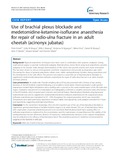| dc.description.abstract | Background
Regional anaesthetic techniques have been used in combination with systemic analgesics during small animal surgery to provide multimodal analgesia. Brachial plexus nerves block using local anaesthetics provides analgesia of the thoracic limb through desensitization of the nerves that provide sensory and motor innervation. This has been shown to reduce intra-operative anesthetic requirements and provide postoperative pain relief. Decreasing the doses of general anaesthetics allows more stable cardiopulmonary function during anaesthesia and the development of less side effects. The present case reports a successful use of brachial plexus blockade to supplement medetomidine-ketamine-isoflurane anaesthesia for repair of radio-ulna fracture in an adult cheetah (acinonyx jubatus).
Case presentation
An adult male Cheetah weighing about 65 kg was presented with a history of leg carrying lameness of the left forelimb sustained following a car accident a week earlier. Clinical examination under general anaesthesia revealed slight dehydration and a swelling with a wound on the caudo-medial aspect of the left radio-ulna region. Crepitation was present on manipulation and radiography confirmed a complete transverse radio-ulna fracture of the left forelimb, which required open reduction and internal fixation. Brachial plexus blockade using lignocaine hydrochloride was used to supplement medetomidine-ketamine-isoflurane anaesthesia for the surgical procedure. Isoflurane anaesthesia was maintained at 0.5 - 2.0% throughout the surgical procedure, which was uneventful. Temperature and cardio-pulmonary parameters remained stable intra-operatively. Limb paralysis extended for 5 hours post-operatively, suggesting prolonged anaesthesia.
Conclusion
To the researchers’ knowledge, this is the first reported case of the use of brachial plexus blockade to supplement general anaesthesia to facilitate forelimb surgery in an adult cheetah. The use of brachial plexus block with a light plane of general anaesthesia proved to be successful. Brachial plexus block had a sparing effect on isoflurane anaesthesia as evidenced by the concentration used for maintenance of anaesthesia and the stability of the cardiopulmonary function. Moreover, absence of autonomic cardiopulmonary reactions to the surgical manipulation may be attributed to the efficacy of brachial plexus block. This anaesthesia protocol is therefore recommended for surgeries of the forelimb in wild cats.
Keywords:
Wild cats; Forelimb fracture; Anaesthesia protocol | en_US |

